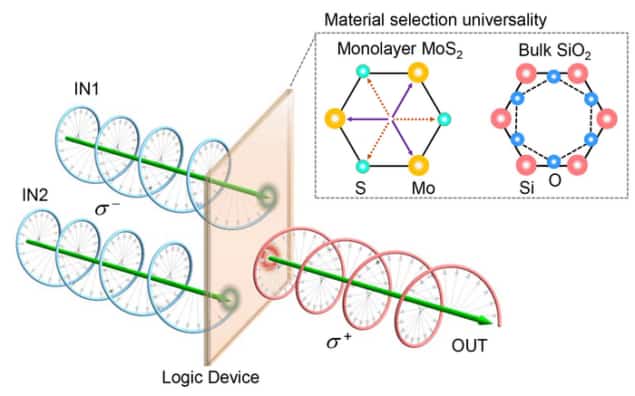
Light-based optical logic gates operate much faster than their electronic counterparts and could be crucial for meeting the ever-growing demand for more efficient and ultrafast data processing and transfer. A new type of “optical chirality” logic gate developed by researchers at Aalto University works about a million times faster than existing technologies.
Like electrons and molecules, photons have a so-called intrinsic degree of freedom known as chirality (or handedness). Optical chirality, which is defined by left-handed and right-handed circularly polarized light, shows great promise for fundamental research and applications such as quantum technologies, chiral nonlinear optics, sensing, imaging and the emerging field of “valleytronics”.
Nonlinear optical material
The new device works by using two circularly polarized light beams of different wavelengths as the logic input signals (0 or 1, according to their specific optical chirality). The researchers, led by Yi Zhang, shone these beams onto atomically thin slabs of the crystalline semiconductor material MoS2 on a bulk silicon dioxide substrate. MoS2 is a nonlinear optical material, that is, it can generate light at a different frequency to that of the input beam.
Zhang and colleagues observed the generation of a new wavelength (the logic output signal). By adjusting the chirality of the two input beams, four input combinations – corresponding to (0,0), (0,1), (1,1) and (1,0) – are possible. In the nonlinear optical process, the generated output signal is considered as logic 1 or logic 0 based on the presence or absence, respectively, of this output signal.
Chiral selection rules
The system works thanks to the fact that the crystalline material is sensitive to the chirality of the input beams and obeys certain chiral selection rules (related to the MoS2 monolayer’s threefold rotational symmetry). These rules determine whether or not the nonlinear output signal is generated.
Using this approach, the researchers were able to make ultrafast (less than 100 fs operating time) all-optical XNOR, NOR, AND, XOR, OR and NAND logic gates, as well as a half-adder.
And that’s not all: the team also showed that a single device could contain multiple chirality logic gates operating at the same time in parallel. This is radically different to conventional optical and electrical logic devices that typically perform one logic operation per device, says Zhang. Such simultaneous parallel logical gates could be used to construct complex, multifunctional logic circuits and networks.

Logic gate breaks speed record
The chirality logic gates can also be controlled and configured electronically in an electro-optical interface. “Traditionally, the connection between electronic and optical/photonic computing has mainly been realized through slow and inefficient optical-to-electrical and electrical-to-optical conversion,” Zhang tells Physics World. “We demonstrate electrical control of the chirality logical gates, opening up an exciting prospect for the first and direct interconnection between electrical and optical computing.”
“Based on this, we hope that all-optical computing modalities can be realized in the future,” says Zhang.
The researchers, who report their work in Science Advances, now hope to improve the efficiency of their chirality logic gates and reduce their power consumption.
